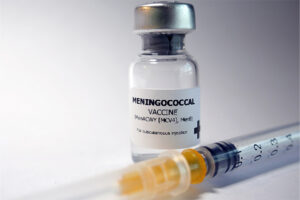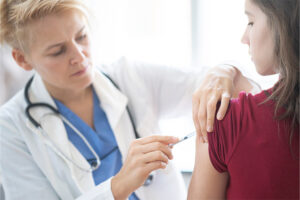Infectious Diseases
Adolescent Vaccinations
Improving Vaccination Uptake and Series Completion Among Adolescents
Although increasingly independent, adolescents, including college-aged students, still benefit from systems that help them take the necessary steps to avoid vaccine-preventable diseases. Parents can also help their adolescents stay up to date on vaccinations.
The adolescent age group can be a population at risk for having gaps in their preventive medical care, for many reasons. It is important to understand the circumstances that can result in a potential gap in medical care and to ensure that adolescents have access to preventive strategies to stay healthy during a period of potential risk. Vaccines that are very effective and can protect adolescents from infections and their complications are available. When discussing vaccination, vaccine efficacy and safety should be considered against the risks of the diseases that they prevent.
As an example, many think of post–COVID-19 infection complications as being rare, something that happened only with the early strains that caused the pandemic, or something that is not happening anymore. If these complications are not thought to be happening anymore with the new strains, they see no reason to get vaccinated. During the COVID-19 pandemic, the development of multisystem inflammatory syndrome in children (MIS-C) was a significant concern for both parents and health care providers. While MIS-C is less common now compared with during the Omicron wave, new subvariants of Omicron are still capable of causing MIS-C and other complications that are seen post COVID-19. Alternatively, we know that these complications are less frequently seen in those who have received the COVID-19 vaccine. Preventing long COVID and post–COVID-19 complications is a reason for adolescents to receive their recommended updated vaccine boosters.
Another factor that may limit vaccine uptake among adolescents occurs as a result of their growing independence as they become young adults. Meningococcal conjugate (MenACWY) vaccination uptake for the first dose (usually recommended to be given at age 11-12 years) is 85% to 90% but drops off to more than 50% for the recommended second dose given at age 17 years, as reported by Pingali et al. This drop-off may be related to multiple reasons, including parents not reminding their college-aged children that they need to get their vaccines or no longer having the pediatrician’s or primary care provider’s office in charge of making sure that they come back for a second dose. As students leave home for college around this age, if the school does not request to verify the completion of a vaccine series, they might not complete it on their own. One way to improve series completion would be to set up systematic reminders for both adolescents and their families and to offer options and information for access to the vaccines on campus or in nearby locations.
It is important to be mindful that turning 18 years old does not necessarily mean that a person is ready to take on all of the responsibilities that are expected of adults in our society. Parents can help their adolescent make taking care of their health a priority, which includes staying up to date on vaccinations. Even something as simple as having access to their immunization records can make a big difference for a young adult. If no one has told an adolescent that they are going to need their health and immunization records, how are they going to know? Along with their primary care provider, a parent can guide the adolescent and young adult to make sure that they continue to complete vaccines at the recommended age to stay healthy.
This topic is relevant because it raises awareness about the gaps in care and about deficiencies within our health care system. Adolescents, including college-aged students, remain dependent on support systems to maintain optimal health. As they become more independent, they could rely on support systems to stay healthy, including those that focus on improving vaccination rates among college-aged students.
Block JP, Boehmer TK, Forrest CB, et al. Cardiac complications after SARS-CoV-2 infection and mRNA COVID-19 vaccination – PCORnet, United States, January 2021-January 2022. MMWR Morb Mortal Wkly Rep. 2022;71(14):517-523. doi:10.15585/mmwr.mm7114e1
Kenney PO, Chang AJ, Krabill L, Hicar MD. Decreased clinical severity of pediatric acute COVID-19 and MIS-C and increase of incidental cases during the omicron wave in comparison to the delta wave. Viruses. 2023;15(1):180. doi:10.3390/v15010180
Lee D, Rundle-Thiele S, Wut TM, Li G. Increasing seasonal influenza vaccination among university students: a systematic review of programs using a social marketing perspective. Int J Environ Res Public Health. 2022;19(12):7138. doi:10.3390/ijerph19127138
Multisystem inflammatory syndrome in children (MIS-C): information for healthcare providers about talking with families and caregivers. Centers for Disease Control and Prevention. Updated January 3, 2023. Accessed November 9, 2023. https://www.cdc.gov/mis/mis-c/hcp/provider-families.html
Pingali C, Yankey D, Elam-Evans LD, et al. National, regional, state, and selected local area vaccination coverage among adolescents aged 13-17 years – United States, 2020. MMWR Morb Mortal Wkly Rep. 2021;70(35):1183-1190. doi:10.15585/mmwr.mm7035a1
Twelve COVID-19 vaccination strategies for your community. Centers for Disease Control and Prevention. Updated November 29, 2022. Accessed November 9, 2023. https://www.cdc.gov/vaccines/covid-19/vaccinate-with-confidence/community.html











